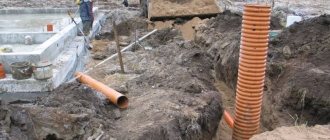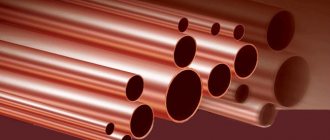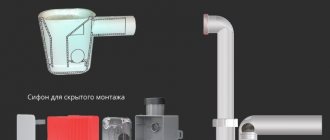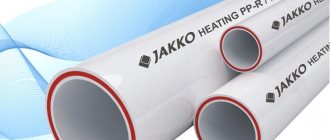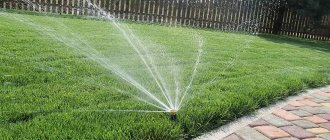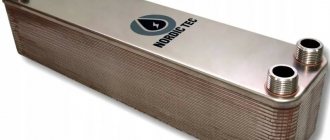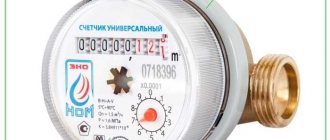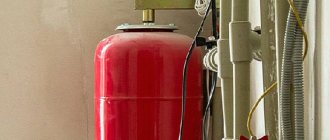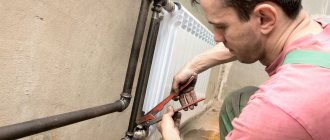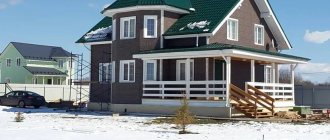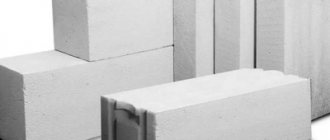- Introduction
- Technical requirements for the sewer pipeline
- Which pipes are best for sewerage?
- What material is best to choose sewer pipes from?
- Size and diameter of sewer pipes for a private house or apartment
- Sewer pipe slope
- Purchasing HDPE pipes at wholesale prices
Requirements for sewer pipes
The common sewer line involves two interconnected systems - internal and external. The choice of pipes for each of them has its own characteristics and requirements. Everything is based on building codes.
External pipeline
Due to the location of the pipes of the external sewer system, they must have the properties of resistance to dynamic and static loads. In other words, they must withstand the deformations that occur when people and vehicles move, and also support the load of the soil laid on top. The connection points must ensure the absence of displacements that could disrupt the integrity of the entire pipeline during the movement of groundwater.
In accordance with SNiP 2.04.03-85, pipes for the external sewage system must be laid below the freezing level of the soil in winter. It will be different for each region of the country. The value for your area must be clarified on the Internet or the meteorological service. In general, for a private house the building level will be 0.5-2 m.
In those areas that are located at intersections with transport routes and increased load, corrugated metal-plastic pipes are laid. They are able to withstand increased loads. This property is due to ring rigidity. In addition, they are characterized by great flexibility. This also makes it possible to lay sewer pipes in particularly complex and non-linear areas.
Internal pipeline
The pipes that are used to create the internal system do not have the above strength requirements. They can be laid in building structures or hidden under decorative elements. Whatever the laying scheme, the internal sewerage system is not subject to the same loads as the external one. But still, to ensure the longest service life, the following properties must be ensured:
- Resistance to mechanical damage;
- Resistance to aggressive environments - temperature, chemical and biological influences;
- Possibility of combination with elements of external sewerage;
- Polished internal surface that does not interfere with the drainage of waste water;
- If necessary, connect all necessary sanitary devices.
Separately, it is worth noting that a significant consumer factor is the ability to easily and simply carry out installation, as well as, if necessary, replace the damaged area. Taking into account all the requirements, the majority of homeowners prefer to use plastic pipes or composite metal-plastic ones.
Next, we will consider possible options for materials for sewer pipes.
Choosing a diameter according to building codes
In contrast to cast iron products, a number of plastic shaped modifications are much richer. ]polymer pipes[/anchor] produce products with diameters from 16 mm to 6000 mm.
The need for a diverse range makes sense:
- the capabilities of pipeline engineering systems are expanding;
- The pipe size is selected taking into account certain tasks;
- it is possible to replace a section of the main line with a pipe with the smallest possible diameter - when laying a sewer system for a private house, this will reduce the budget for repair work.
The most popular standard sizes for the internal drainage network: 50/100/150 mm.
The diameter of the pipe is selected in accordance with the service area. For example, a pipeline of 100, 110 or 150 mm is installed under a vertical riser and toilet
Scope of application of pipes based on the flow area:
- 16-25 mm – removal of uncontaminated liquid from ventilation units, air conditioners and dehumidifiers;
- from 32 mm – connection of a washbasin or sink used for washing conditionally clean dishes (glasses, wine glasses, etc.);
- from 40 mm – drain for a bathtub, shower, kitchen sink, dishwasher or washing machine;
- 50 mm or more – simultaneous connection of a shower and bathtub, laundry room;
- 60-75 mm – combined connection of three and five devices, respectively, with the exception of the toilet.
Dimensions are measured from the inside and reflect the nominal diameter of the line. Considering the wall thickness, the external size exceeds the internal size.
In addition to the diameter, when choosing polymer pipes you should pay attention to the following points:
Image gallery
Photo from
Marking of polymer pipes by ring stiffness
Use of pipes with low ring stiffness
Connecting elements of polymer pipes
Polymer pipes for external sewerage
Asbestos cement pipes
Made from a mixture of cement and asbestos fiber. Among the advantages are the following:
- Long service life (50-100 years);
- Resistance to aggressive influences. Capable of passing any type of liquid;
- Light weight. This property can facilitate installation;
- The inner surface is resistant to clogging. This means that the internal lumen decreases very slowly.
- Easy to install. The installation process can be carried out without the use of any special tools.
But there are also disadvantages. These include significant fragility and instability to mechanical stress. Most often problems occur at the ends of pipes. Therefore, when purchasing, you should pay attention to them.
Ceramic pipes
Sewage pipes from this material were made in ancient times. Nowadays, ceramics continue to be popular in certain situations. Everything is explained by the significant advantages of the products:
- Resistant to chemicals. Provide the ability to move any type of liquid;
- The inner surface has virtually no roughness. This reduces the risk of blockages;
- Not exposed to temperature;
- Easy installation.
However, among the disadvantages there is also fragility. This imposes certain restrictions on the installation process and transportation. In addition, it is necessary to note the short length of the pipe sections. This helps to increase the number of joints in the highway.
Cast iron pipes
Until recently, sewer pipes made of cast iron were a traditional common solution. The most popular size is 160 mm. The material has many advantages:
- Highly durable. Able to withstand significant loads;
- Long service life;
- Resistance to corrosive influences;
- Resistance to aggressive liquids and temperature changes;
- Easy to install.
However, the most significant disadvantage is the weight. This leads to the fact that during installation it is often necessary to use special equipment. In addition, the inner surface has increased roughness. This property contributes to the formation of deposits and blockages. Despite the resistance to aggressive environments, there is one limitation. It cannot be used in conjunction with saline solutions or in saline soil.
Video description
The plastic variety (Russian name - PE, international - PE), is widely used in external drainage systems:
PVC pipes
Polyvinyl chloride sewer pipes (PVC in international transcription) are mainly used for arranging sewer systems in residential buildings. Among the advantages of such products are:
- long-term operational period (40-50 years);
- reduced flammability and ultraviolet resistance;
- resistance to corrosion and clogging;
- light weight and easy installation (easy to cut and bend).
Smooth PVC pipes are used where there is no heavy load on the ground Source yandex.by
When using, it is necessary to take into account some features of the products:
- The disadvantage that limits the use of PVC pipes is the high coefficient of thermal expansion (change in linear size under the influence of temperature). If the liquid is heated to 60°C or higher, the tightness of the joints decreases, which can lead to leakage.
- The plasticity of the material decreases at low temperatures. Operation of the pipeline without insulation is allowed in the range from 0 to -15°C.
PVC pipes
Polyvinyl chloride is one of the most affordable materials. Sewage pipelines made of this material have the following advantages:
- Polished walls. No deposits are formed;
- High strength;
- Low temperature resistance. It will not crack even if it freezes completely;
- Light weight;
- Ease of installation;
- Resistance to corrosive influences;
- Low price;
- High level of wear resistance.
The main disadvantage is the thermal elongation of the product. That is why they are not used in pipelines in which liquids with temperatures exceeding 60⁰С are transported.
The parameters of such products may vary depending on the type of production. So, now you can find single-layer and three-layer PVC pipes. Products can be divided by hardness:
- Class "S". Tough. Used for laying at depths of up to 8 meters. Maximum wall thickness.
- Class "N". Medium hard. For a depth of 2-6 meters.
- Class "L". Lungs. Depth 0.8-2 meters.
Popular model: EKODIN 5
up to 5 people
recycling 1 cubic m. per day.
Max. dump 250 l.
Check prices
Your own home surrounded by nature, as an ecologically clean area, can be an ideal place to live. But this is only possible with careful preparation of all the necessary elements of comfort, which include sewerage.
You don't notice it when it is installed according to all the rules. But at the slightest violation, it can remind itself of itself with leaks and an unpleasant odor.
The most important task when installing a sewer system is the correct choice of pipes, the properties of which determine the final result of the work. On this specific issue, let us turn to the experience of specialists.
Polypropylene pipes
Such products are ideal for creating external or storm drainage systems. Among the advantages are the following:
- Resistance to temperature and corrosion;
- Inertness to chemicals;
- Polished inner surface. It is possible to get clogged due to incorrect installation;
- High service life;
- Light weight;
- Easy to install.
The range of polypropylene pipelines is huge. It is possible to find elements for a system of any complexity.
Installation nuances
There are a number of nuances in the installation of sewerage systems, which, if ignored, can result in not a good drainage and drainage system, but, in Russian speaking, large hemorrhoids. So I will list as much as possible:
- When cutting pipes, the cut must be strictly perpendicular to the axis and must be processed with sandpaper;
- The elements to be glued must be degreased;
- Fittings with a rubber seal must be coated with silicone sealant;
- The cross-section of the horizontal pipeline should not exceed the diameter of the sewer riser;
- In places where the pipeline turns, it is necessary to install revisions - cleaning holes with a cover;
- Horizontal connections must be made from angles and oblique tees;
- Sewerage is secured at intervals equal to 10 x pipe diameter;
- The slope of horizontal sections should not exceed 1-2cm/1m;9. The bell is positioned towards the moving liquid.
Polyethylene pipes
They are another type of plastic pipe. Also popular when installing external sewerage. Advantages:
- Durable;
- Temperature resistant;
- Easy installation;
- Polished inner surface.
However, among the disadvantages of polypropylene products is high sensitivity to ultraviolet radiation. In this regard, the material can only be used excluding exposure to the sun.
Which material should you choose?
Since in the article we are considering the question of which pipes are better than a private house, we will summarize what to choose.
- Concrete and reinforced concrete - used in industrial construction. Local sewer networks are constructed from them. They differ in significant weight and dimensions.
- Cast iron is high-strength, temperature-resistant, but heavy. Now they are not used often. Even in multi-apartment construction, the volume of their use is decreasing. Even despite the long service life.
- Steel, ceramic and copper are too expensive and not very reliable for use in sewers. The installation and replacement process is complex.
- Asbestos-cement - resistant to biological and chemical influences. Quite suitable for sewer networks. However, fragility reduces their performance even before installation.
- Polymers are a relatively new type of product. There are models with different consumer characteristics. The class includes various plastic pipes for sewer networks. They are distinguished by significant strength, long service life, ease of installation and compatibility with other equipment.
- PVC pipes are the best choice for gravity sewerage. Suitable for installation of external and internal systems. Resistant to mechanical damage and ultraviolet radiation. Temperature does not affect performance. They do not tolerate exposure to household chemicals very well.
- Polypropylene - not exposed to aggressive chemicals. Resistant to mechanical damage. Capable of passing high temperature liquids.
The sewer pipe market is much broader than described in the article. Here are the characteristics of the most common materials. It is impossible to say for sure that one of the options is better than the others. For each pipeline, specific operating conditions must be taken into account. It is by taking into account all the nuances of the site that you can choose the best option.
We recommend reading:
- How to connect plastic sewer pipes;
- How to independently determine the diameter of the pipe;
- Methods for connecting a metal pipe to a plastic one
Internal sewerage
Internal sewerage runs in the house itself and is connected to the external one under or through the foundation. For the internal pipeline, rigidity is not so important; the load on it is several times less. But other general requirements remain:
- Durability. Nobody wants to change the pipeline every two or three years. Especially when there are materials with a service life of 50 years or more.
- Easy replacement. To replace old sewers, major repairs are carried out. It is better if the pipeline can be easily replaced in case of breakdown.
- Soundproofing. Pipes for internal sewerage must isolate the sounds of sewage movement from the inhabitants of the house.
- Ease of installation. Some plastic pipes can be easily installed by a non-professional. The easier the installation, the faster the sewer construction takes place.
- Non-toxic. Pipes must be non-toxic and not release toxic substances upon contact with wastewater.
- Smooth inner surface. The sewer will silt and become clogged if the inner walls of the pipes are rough.
In addition, the internal and external water pipes must be easily connected to each other. If they do not connect well, the joint between them will become clogged or leak. This is especially important when partially replacing the pipeline.
Go ahead. Let's consider which pipes are most suitable for sewer systems:
- PVC pipes,
- PE pipes,
- PP pipes,
- asbestos-cement,
- concrete,
- cast iron,
- ceramic.
